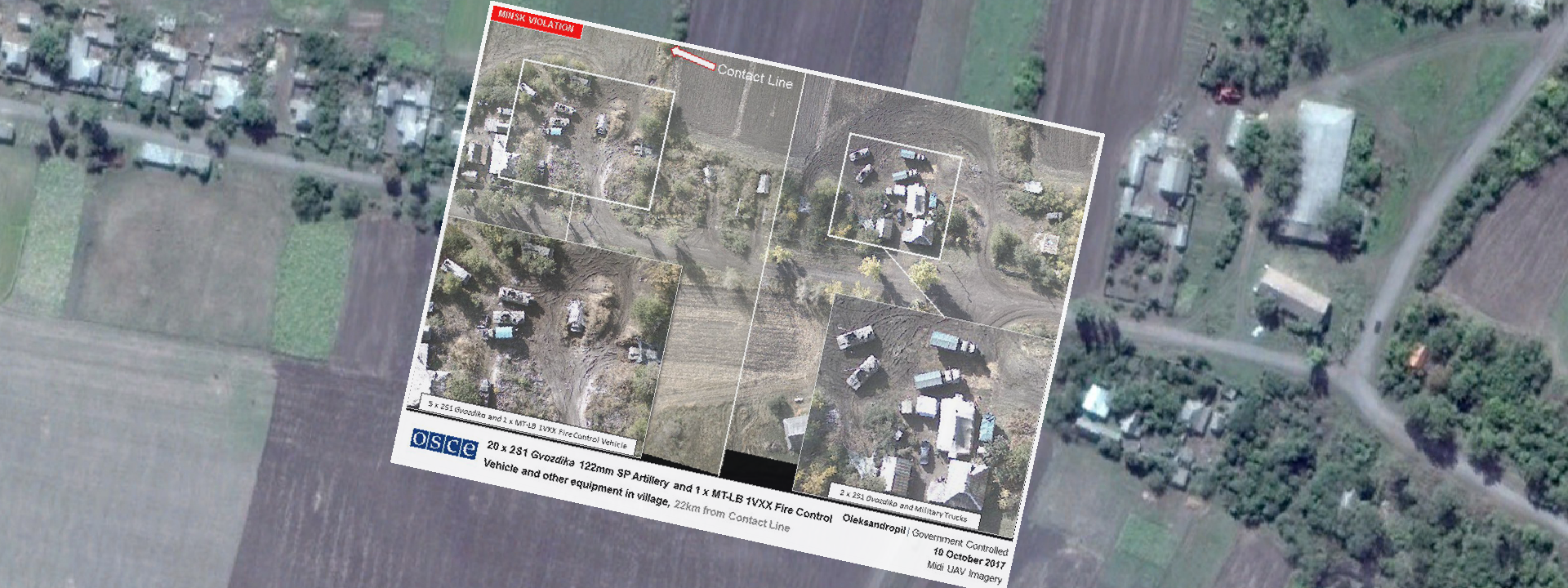OSCE SMM Observes Banned Weapons…Again
Heavy weapons indicate locations of military fortifications on the line of contact in theDonbas
OSCE SMM Observes Banned Weapons…Again

Heavy weapons indicate locations of military fortifications on the line of contact in the Donbas

In the Organization for Security and Co-operation’s Special Monitoring Mission (OSCE SMM) to Ukraine’s weekly media update at the Ukraine Crisis Media Center, Principal Deputy Chief Monitor Alexander Hug reported a 45 percent increase in ceasefire violations from the previous week, a continuation of a recent growth pattern seen in eastern Ukraine. As part of the OSCE SMM’s weekly briefing, the SMM released UAV imagery evidence of their observations — @DFRLab looked into these areas and found military positions and fortifications among more residential areas.

As kinetic activity continues to rise, there is increased risk for severe escalation in the conflict, which is a particularly dangerous prospect during the upcoming winter season. Several cities and towns along the line of contact already face difficulty in accessing critical infrastructure such as water, gas, and electricity; many of these facilities have gone unrepaired due to ongoing fighting in the immediate vicinity. In winter conditions, unrepaired critical infrastructure facilities are at risk of further damage from low temperatures and are even more difficult to repair.
Heavy Weapons and Military Positions
Since the new ceasefire agreement on August 25, fighting steadily increased, including the first observed use of multiple launch rocket systems (MLRS) in two months. MLRS systems are particularly problematic within the Minsk agreements and wider humanitarian situation on the ground due to their indiscriminate nature. Put simply, incendiary artillery fire hits an area, as opposed to a single target. In the conflict in eastern Ukraine, the human impact of this distinction includes civilian casualties, houses burning down, and other humanitarian emergencies.

Novoselivka
As noted in the OSCE SMM’s daily report with information from October 12, in violation of the Minsk agreements, the SMM observed five 2S1 “Gvozdika” 122mm self-propelled (SP) artillery, ten main battle tanks (MBT) armed with 125mm guns (probably T-64), three MT-12 Rapira 100mm anti-tank guns, three BMP-1 infantry fighting vehicles (IFV), and two MT-LB armored personnel carriers (APC) in non-government-controlled Novoselivka, Donetsk Oblast.

The area around Novoselivka is heavily forested, making it the prime location to try to hide weapons prohibited by the Minsk agreements. While the SMM’s UAV imagery does not give enough information for a definitive geolocation, it has pointed to extensive military fortifications in the area.



The area below is particularly notable, with extensive entrenchment and likely heavy weapons positions scattered in and around the forest. Additionally, when looking at satellite imagery from winter, when the trees no longer have leaves, expansive military positions and even military vehicles throughout the forest are revealed.


Oleksandropil
Additionally, as noted in the OSCE SMM’s daily report with information from October 11, also in violation of the Minsk agreements, the SMM observed twenty 2S1 “Gvozdika” 122mm self-propelled (SP) artillery, one MT-LB 1VXX fire control vehicle, and several other military vehicles among residential areas of government-controlled Oleksandropil, Donetsk Oblast. Military presence embedded among residential areas is not uncommon on both sides of the contact line, but equally dangerous to civilian populations both ways.

Note that 2S1 “Gvozdika” 122mm self-propelled (SP) artillery systems (NATO reporting name M1974) are prohibited by the heavy weapons clause of the Minsk agreements due to their large calibre. In the conflict in eastern Ukraine, 122mm shells have been frequently observed damaging critical infrastructure and residential buildings.



Conclusion
To reiterate, this is only one small case among many in the Donbas. Minsk-prohibited heavy weapons are scattered along the line of contact, causing serious endangering civilian lives, residential areas, and critical infrastructure. Increased use of heavy weapons is a sign of potential escalation due to the close proximity of opposing Ukrainian and Russian-led separatist positions. @DFRLab will continue to monitor open source information around the humanitarian impact of violations to the Minsk agreements.
Follow the latest Minsk II violations via the @DFRLab’s #MinskMonitor.
Also, follow @DFRLab on Twitter for more in-depth analysis from our #DigitalSherlocks.

